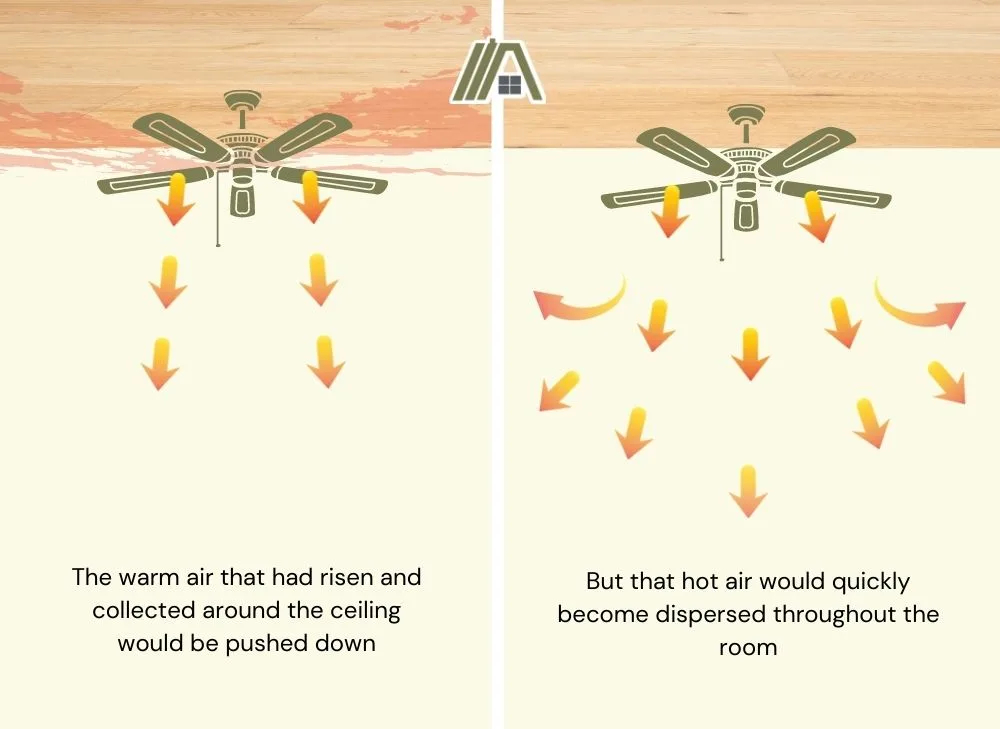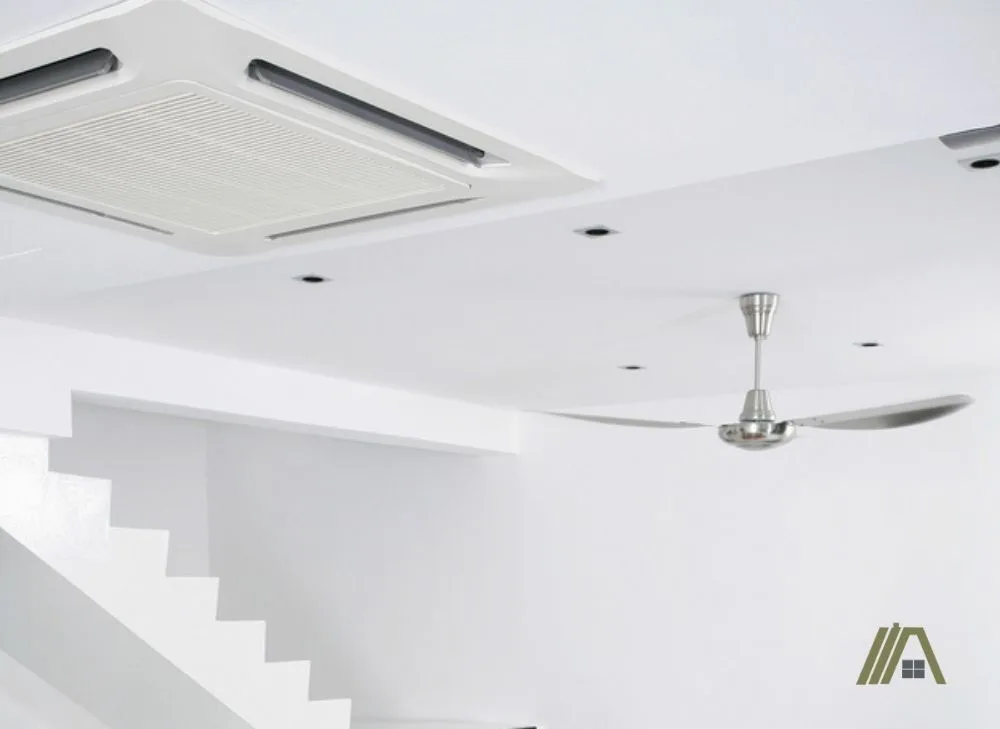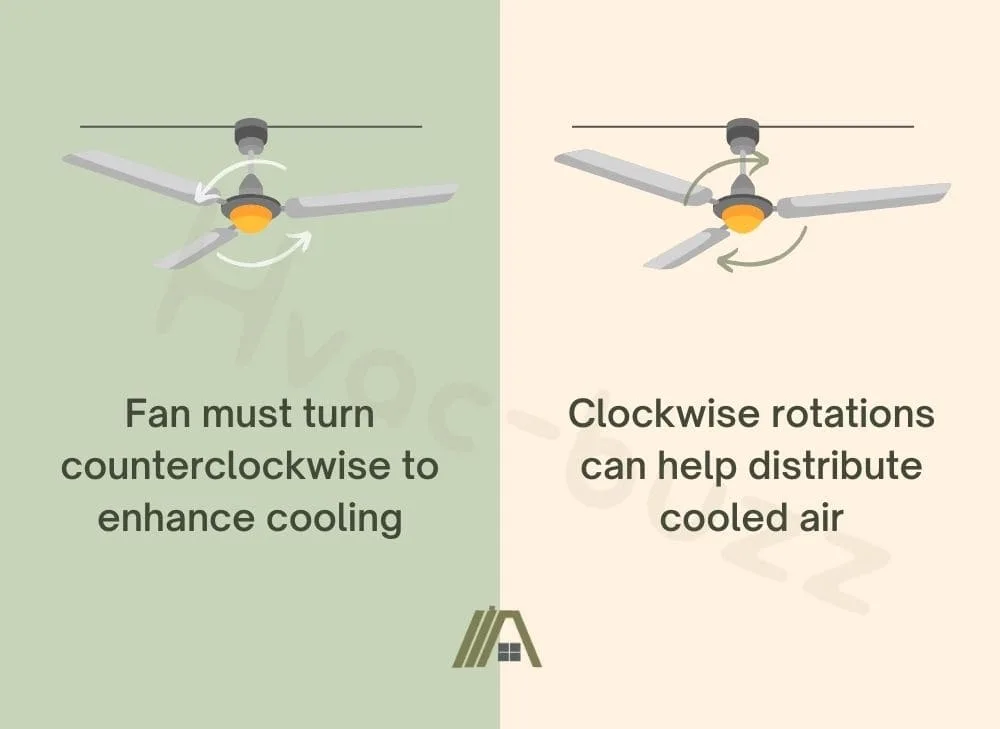A ceiling fan and an AC can both contribute to cooling you down in a room on a warm Summer’s day. However, there has been some controversy as to whether having both running concurrently is a good idea.
While many believe that running both at the same time will cost you more money or one will negate the other, that is not the case; there are actually quite a few benefits of actually doing so.

Using a ceiling fan with an AC makes both systems more efficient. The thermostat doesn’t have to be set so low because of the fan’s windchill effect, and the fan doesn’t have to be at such a high speed because the air moving over an occupant is actually colder.
Myth: Ceiling Fans Push Hot Air Down
There is a misconception that having your ceiling fan on at the same time as your AC is a waste and a bad idea. This is supposedly because your ceiling fan pushes the air that is at ceiling level down into the occupied parts of the room.
Since hot air rises, it accumulates by the ceiling fan, which means that the fan will be distributing the hot air, making the room warmer. If the room is hotter, the air that is taken in by the AC will need to be cooled more to reach the desired temperature, which will require more energy.
In addition, the hot air moving through the room would make a person lower the thermostat even further to try and counteract this. This will, in turn, further increase the total energy consumption and raise your energy bill.
However, this is not entirely true. While hot air around the ceiling fan is technically pushed down into the room, this air is not going to be drastically hotter than the air at occupant level. Moreover, the fan is constantly circulating the air while it is on.
So, when the fan is first switched on, the warm air that had risen and collected around the ceiling would be pushed down but it would quickly become dispersed throughout the room. Thus, the hot air would not be concentrated at any one point and the temperature would not be higher than it was before the ceiling fan was turned on.

Any warm air will only gather at ceiling level again when the fan has been turned off and the room is left stagnant for a while.
There are certain scenarios in which ceiling fans do actually push hot air down, but this does not mean that they push hot air down into the occupied space. If you install a ceiling fan in a loft, then the fan can stop rising hot air from settling in this space while you occupy it.
AC and Ceiling Fan Have Different Cooling Functions
While both the AC and the ceiling fan have a cooling ability, they have different ways of providing this function.
The AC removes the hot air in a room and replaces it with cooled air. This air will not be circulated by the AC itself, except in the areas right by the vents. The cool air will disperse throughout the room slowly. You are cooling in a room with an AC because the ambient temperature drops.
On the other hand, ceiling fans do not actually decrease the temperature of the room at all. They simply circulate the air. In a room with a ceiling fan, you are cooled via the windchill effect, but only if you are within the path of the fast-moving air.
Now, if you were to cool the air with the AC and disperse it rapidly with the ceiling fan, you get a highly efficient cooling system.
Benefits of Running Ceiling Fan and AC Together
From the explanations above, it is clear that running both the fan and AC concurrently can be a good idea. Here are some reasons why.
You Don’t Have to Set the Thermostat so Low
A great benefit of running both mechanisms together is that you won’t need to set your thermostat so low, which saves money. The reason for this is that the windchill effect, enhanced by the AC-lowered temperature of the air passing over your skin, makes a room feel cooler than it actually is.
In response, you can set your thermostat to a warmer temperature, closer to the actual air temperature and less energy is needed to keep the air in the room at this temperature.
On average, a medium-powered (36-75W) ceiling fan can cost you around $4-$8 per month, with a higher-powered fan (76-120W) reaching almost $12.
A 6kw AC can cost you around $34 a month when set at 75 °F (24 °C), which is the recommended temperature setting to achieve the greatest energy efficiency. Setting it even slightly lower at 70 °F (21°C) can cost you nearly $10 more each month, so you can see why keeping the thermostat at a higher temperature really pays off.
Think about it this way, running your ceiling fan in summer mode (counterclockwise direction) at the same time as your AC (when set at a higher, average temperature) would cost you less than decreasing the temperature on your AC.

A ceiling fan with an Energy Star rating (ensuring it promotes energy efficiency) is known to be around 40% more energy efficient than regular models, so you can look at saving even more on your monthly bill if you install one of these models.
Counteract Poorly Placed AC Vents
Ceiling fans can help with circulating the air when you have poorly placed AC vents.
If the vents are lower to the floor, as is typical of older homes, you won’t really feel the cold air because cold air sinks. Therefore, any cool air being released from the AC vent will just accumulate at your feet.
Your toes will be nice and fresh, while the rest of you won’t really benefit from it as the temperature of the room remains largely unaffected.
By adding in the running ceiling fan, cool air released from the AC will be able to circulate around the room, dispersing the cold air efficiently. Your entire room will feel the effects of the cool air that has been pulled up from the lower parts of it.
You Can Avoid Buffetting Ceiling Fan Speeds
When you only have a ceiling fan in your room as the source of cooling, putting it at a higher speed can make it more effective in cooling you down. The more movement there is, the cooler you may feel.
However, not everyone likes to be bombarded with a strong wind throughout the day or night (if you sleep with the ceiling fan on). Using the fan with your AC means you will be able to put the fan on a lower speed setting and still achieve the level of cooling you desire.
The air that meets your body won’t be as harsh, but your body will actually be cooler as the temperature of the moving air will be cooler.
Turn the Fan off When You Aren’t in the Room
A good piece of advice would be to not have the fan running in an unoccupied room.
The fan only makes a room feel colder to individuals that are inside it, due to wind chill. Wind chill allows the overall feel of a space to appear cooler, even if the air temperature has not been reduced.
If there is no one occupying the room while the AC and fan run, then there is no one to benefit from the moving air. Keeping the fan running in such situations really is a waste of money.
To save even more, consider turning off the AC in that particular room as well when you know you won’t be in it for a while.
,

Fan Must Turn Counterclockwise To Enhance Cooling
When the ceiling fan turns counterclockwise, the blades direct air downwards because, in this mode, the highest point of the pitched blade leads the rotation.
Air is then directed downward by following the angle of the blade. This is the summer mode of the fan, and this mode enhances cooling in the presence of the operating AC.
Clockwise Rotations Can Help Distribute Cooled Air
On the flip side, the fan functions in winter mode when it rotates clockwise (not all ceiling fans have this functionality).
When in winter mode, the fan displaces the warmer air closer to the ceiling with cooler air pulled up from the occupied zone. This space is then filled with the warmer air. While the purpose of this mode is to help warm the room, it does not actually drastically change the temperature without the addition of a heat source.
Without a heat source, this function of the fan is actually only really effective at creating air circulation throughout the room. When the AC is running, the air that is circulating is cold. So, using the AC with a clockwise spin of the ceiling fan helps to evenly distribute the conditioned air to prevent pockets of much colder or much warmer air from forming.
In addition, the airflow produced in winter mode is much more gentle. You forgo the added cooling mechanism of wind chill but you also avoid being buffeted entirely. So, this is a great option if the blowing from the fan’s summer mode is uncomfortable.
Sometimes, it’s not as straightforward as summer mode in summer and winter mode in winter. Sometimes, it depends on where you vents and registers are located:
Sources
https://www.canstarblue.com.au/electricity/air-con-temperature-costing/
https://learnmetrics.com/how-much-does-it-cost-to-run-an-air-conditioner-per-hour/

